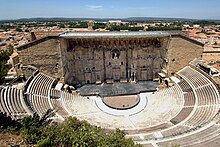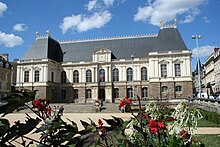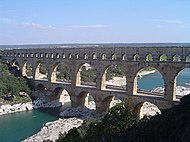Tourism in France

France was visited by 84.7 million foreign tourists in 2013, making it the most popular tourist destination in the world.[1] It is third in income from tourism due to briefer visits. 20% more tourists spent less than half as much as they did in the United States.[2]
France has 37 sites inscribed in UNESCO's World Heritage List and features cities of high cultural interest (Paris being the foremost, but also Toulouse, Strasbourg, Bordeaux, Lyon, and others), beaches and seaside resorts, ski resorts, and rural regions that many enjoy for their beauty and tranquillity (green tourism). Small and picturesque French villages of quality heritage (such as Collonges-la-Rouge or Locronan) are promoted through the association Les Plus Beaux Villages de France (litt. "The Most Beautiful Villages of France"). The "Remarkable Gardens" label is a list of the over two hundred gardens classified by the French Ministry of Culture. This label is intended to protect and promote remarkable gardens and parks.
In 2012, travel and tourism directly contributed EUR77.7 billion to French GDP, 30% of which comes from international visitors and 70% from domestic tourism spending. The total contribution of travel and tourism represents 9.7% of GDP and supports 2.9 million jobs (10.9% of employment) in the country.[3] Tourism contributes significantly to the balance of payments.
Statistics
- Arrivals by country
Most tourists arriving to France in 2014 came from the following countries:[4]
| Rank | Country | Number of tourists |
|---|---|---|
| 1 | 12,800,000 | |
| 2 | 11,800,000 | |
| 3 | 9,300,000 | |
| 4 | 7,500,000 | |
| 5 | 6,200,000 | |
| 6 | 6,100,000 | |
| 7 | 5,500,000 | |
| 8 | 3,200,000 | |
| 9 | 1,700,000 | |
| 10 | 1,400,000 |
- Number of stays
Most nights spent in France in 2014 by tourists from following countries:[5]
| Rank | Country | Number of nights |
|---|---|---|
| 1 | 86,400,000 | |
| 2 | 79,700,000 | |
| 3 | 59,500,000 | |
| 4 | 43,600,000 | |
| 5 | 42,700,000 | |
| 6 | 34,700,000 | |
| 7 | 33,600,000 | |
| 8 | 27,600,000 | |
| 9 | 12,000,000 | |
| 10 | 11,400,000 |
Paris

Paris, the capital city, is the third most visited city in the world.[6] Paris has some of the world's largest and renowned museums, including the Louvre, which is the most visited art museum in the world, but also the Musée d'Orsay, mostly devoted to impressionism, and Beaubourg, dedicated to Contemporary art. Paris hosts some of the world's most recognizable landmarks such as the Eiffel Tower, which is the most-visited paid monument in the world,[7] the Arc de Triomphe, the cathedral of Notre-Dame or the Sacré-Cœur. The Cité des Sciences et de l'Industrie is the biggest science museum in Europe.[8] Located in Parc de la Villette in Paris, France, it is at the heart of the Cultural Center of Science, Technology and Industry (CCSTI), a center promoting science and science culture. Near Paris is the Palace of Versailles, the former palace of the kings of France, now a museum.
French Riviera

With more than 10 million tourists a year, the French Riviera (or Côte d'Azur), in south-eastern France, is the second leading tourist destination in the country, after the Parisian region.[9] According to the Côte d'Azur Economic Development Agency, it benefits from 300 days of sunshine per year, 115 kilometres (71 mi) of coastline and beaches, 18 golf courses, 14 ski resorts and 3,000 restaurants.[10] Each year the Côte d'Azur hosts 50% of the world's superyacht fleet, with 90% of all superyachts visiting the region's coast at least once in their lifetime.[11]
Provence
A large part of Provence is designed as the 2013 European Capital of Culture. Numerous of famous natural sites can be found in the region, as the Gorges du Verdon, the regional natural park of Camargue, the national park of calanques and the typical landscape of Luberon. Provence hosts dozens of renowned historical sites like the Pont du Gard, the Arles' Roman Monuments or the Palais des Papes in Avignon. Several cities also attracts a lot of tourists, like Aix-en-Provence, Marseille or Cassis, on the Mediterranean Sea coastline.
Loire Valley

An other major destination are the Châteaux of the Loire Valley, this World Heritage Site is noteworthy for the quality of its architectural heritage, in its historic towns such as Amboise, Angers, Blois, Chinon, Nantes, Orléans, Saumur, and Tours, but in particular for its castles (châteaux), such as the Châteaux d'Amboise, de Chambord, d'Ussé, de Villandry and Chenonceau, which illustrate to an exceptional degree the ideals of the French Renaissance.
Notable French cities





France has many cities of cultural interest, some of them are classified as "Town of Art and History" by the French Ministry of Culture.

- Aix-en-Provence
- Amiens and its cathedral
- Annecy with the lake and the mountains (French Alps)
- Avignon with the Popes' palace.
- Arles: Arles has important remains of Roman times, which have been listed as World Heritage Sites since 1981, notably its amphitheatre, the The Alyscamps, its Obelisk and Barbegal aqueduct and mill.
- Bayeux and its Tapestry Museum, housing the tapestry
- Bordeaux: Bordeaux is classified "Town of Art and History". The city is home to 362 monuments historiques (only Paris has more in France) with some buildings dating back to Roman times. Bordeaux has been inscribed on UNESCO World Heritage List as "an outstanding urban and architectural ensemble". Bordeaux is home to one of Europe's biggest 18th-century architectural urban areas, making it a sought-after destination for tourists and cinema production crews. It stands out as one of the first French cities, after Nancy, to have entered an era of urbanism and metropolitan big scale projects, with the team Gabriel father and son, architects for King Louis XV, under the supervision of two intendants (Governors), first Nicolas-François Dupré de Saint-Maur then the Marquis (Marquess) de Tourny.
- Cluny with its Abbey and its medieval city
- Carcassonne and its medieval fortress
- Chartres and its cathedral
- Deauville
- Dijon with its cathedral and the Palace of the Dukes of Burgundy
- Giverny
- Honfleur
- La Rochelle
- Lille
- Lyon: its historical centre was designated a UNESCO World Heritage Site in 1998. In its designation, UNESCO cited the "exceptional testimony to the continuity of urban settlement over more than two millennia on a site of great commercial and strategic significance."[12] The specific regions composing the Historic Site include the Roman district and Fourvière, the Renaissance district (Vieux Lyon), the silk district (slopes of Croix-Rousse), and the Presqu'île, which features architecture from the 12th century to modern times.[13]
- Mâcon, well known for its wine and the Rock of Solutre.
- Marseille, known for the Calanques National Park, the new MuCEM, the basilica of Notre-Dame de la Garde, the Stade Vélodrome, the Palais Longchamp or the Vieux-Port de Marseille
- Metz: Metz possesses one of the largest Urban Conservation Area in France and more than 100 buildings of the city are classified on the Monument Historique list.[14][15] Because of its historical and cultural background, Metz benefits from its designation as "Town of Art and History".[16] The city features noteworthy buildings such as the Gothic Saint-Stephen Cathedral, the Basilica of Saint-Pierre-aux-Nonnains, its Station Palace, or its Opera House, the oldest one working in France. Metz is home to some world-class venues including the Arsenal Concert Hall and the Centre Pompidou-Metz Museum, the most visited art venue in France outside Paris.[17]
- Mulhouse, home of the French Automobile Museum and the French Railway Museum
- Nancy with the Place Stanislas, Place de la Carrière and Place d'Alliance, UNESCO World Heritage Sites since 1983.
- Nantes with the Castle of the Dukes of Brittany
- Narbonne
- Nice
- Nîmes: Nîmes displays many remains of the Roman Empire including the Maison Carrée, the Arena of Nîmes and the nearby Pont du Gard.
- Orange (city): the city displays many Roman remains, including the Théâtre Antique and the Triumphal Arch.
- Perpignan with its cathedral and the Palace of the Kings of Majorca
- Rennes with its Parlement of Brittany, its cathedral, its cultural center Les Champs Libres, its Thabor parc and its medieval streets with many half-timbered houses.
- Rouen with its cathedral, castle and half-timbered houses
- Sens
- Strasbourg: Strasbourg's historic city centre, the Grande Île (Grand Island), was classified a World Heritage site by UNESCO in 1988, the first time such an honour was placed on an entire city centre.
- Toulouse: with two UNESCO World Heritage sites, the Canal du Midi and the largest Romanesque building in the Europe the Saint-Sernin Basilica. The city historic centre also hosts the 13th-century gothic monastery Ensemble conventuel des Jacobins (burial place of Saint Thomas Aquinas) or again the 16th-century bridge Pont Neuf, Toulouse.
- Vernon
- Versailles
The most beautiful villages of France

Les Plus Beaux Villages de France ("The most beautiful villages of France") is an independent association, created in 1982, that aims to promote small and picturesque French villages of quality heritage. As of 2008, 152 villages in France have been labelled as the "Plus Beaux Villages de France".
There are a few criteria before entering the association: the population of the village must not exceed 2,000 inhabitants, there must be at least 2 protected areas (picturesque or legendary sites, or sites of scientific, artistic or historic interest), and the decision to apply must be taken by the town council.
Other parts of France


In the eastern parts of France there are skiing resorts in the Alps.
Tourists also travel to see the annual cycle race, the Tour de France.
France's Mediterranean beaches on the French Riviera, in Languedoc-Roussillon, or in Corsica, are famous. Away from the mainland tourists are French Polynesia (especially Tahiti), the Caribbean islands Martinique, Guadeloupe, Saint Martin and Saint Barthélemy.
The Route Napoléon, the route taken by Napoléon in 1815 upon his return from exile, leads from Golfe-Juan to Grenoble in south-eastern France. It is a scenic byway and a popular destination.[18]
Also popular are the memorials to the battles of the First and Second World Wars. Memorials to the former include the Memorial to the Missing of the Somme, while commemorations to the latter include a D-Day museum at Arromanches, one of the landing sites.
There are too a lot of great naturals sites, with important flora collections. For example, the federal Arboretum de Pézanin gather one of the richest forest collection in France, or the Regionals natural Park, which are dispersed in all the territories.
Religious pilgrimage
France attracts many religious pilgrims on their way to St. James, or to Lourdes, a town in the Hautes-Pyrénées that hosts a few million visitors a year. The Taizé Community has become one of the world's most important sites of Christian pilgrimage. Over 100,000 young people from around the world make pilgrimages to Taizé each year for prayer, Bible study, sharing, and communal work.
Theme Parks

Disneyland Paris is France's and indeed Europe's most popular theme park, with 15,405,000 combined visitors to the resort's Disneyland Park and Walt Disney Studios Park in 2009.[19] The historical theme park Puy du Fou in Vendée is the second most visited park of France.[20] Other popular theme parks are the Futuroscope of Poitiers and the Parc Astérix.
Most popular sites by number of visitors

The most popular tourist sites include (visitors per year):[17][21]
- Louvre Museum (8.5 million),
- Eiffel Tower (6.2 million),
- Palace of Versailles (6 million),
- Centre Pompidou (3.6 million),
- Musée d'Orsay (2.9 million),
- Musée du quai Branly (1.3 million),
- Arc de Triomphe (1.2 million),
- Mont Saint-Michel (1 million),
- Notre-Dame de la Garde, Marseille (800,000),[22]
- Château de Chambord (711,000),
- Sainte-Chapelle (683,000),
- Metz Cathedral (652,000),[23]
- Bastille (Grenoble) (600 000)
- Centre Pompidou-Metz (550,000),[23]
- Château du Haut-Kœnigsbourg (549,000),
- Puy de Dôme (500,000),
- Musée Picasso (441,000),
- Carcassonne (362,000).
Gallery
-
Angles-sur-l'Anglin, one of the "Most beautiful villages of France".
-
The Pont du Gard, a Roman vestige.
-
The Palace of the popes in Avignon.
-
Ski resort in Megève.
-
Ruins of the medieval castle of Bourbon-l'Archambault.
-
Castelbouc near Sainte-Enimie (Tarn)
-
The Verdon Gorge is a popular destination for kayaking.
-
Surf in Hossegor.
-
The Rock of Solutre, Grand Site de France.
See also
- List of museums in France
- List of castles in France
- List of cathedrals in France
- List of basilicas in France
- List of medieval bridges in France
- List of spa towns in France
- List of ski resorts in France
- List of World Heritage Sites in France
- National parks of France
- Regional natural parks of France
References
- ^ "UNWTO Highlights" (PDF). United Nations World Tourism Organization. Retrieved 11 September 2013.
- ^ Dilorenzo, Sarah (July 20, 2013). "France learns to welcome, to speak 'touriste'". The Burlington Free Press. Burlington, Vermont. pp. 5A. Retrieved July 20, 2013.
- ^ "2013 Travel & Tourism Economic Impact Report France" (PDF). World Travel & Tourism Council. Retrieved 2013-11-26.
- ^ Visiteurs internationaux en France en 2014
- ^ Visiteurs internationaux en France en 2014
- ^ "France". Travel-university.org. 2010-07-28. Retrieved 2013-09-30.
- ^ "The Leading Travel Zone Site on the Net". travelzones.net. Retrieved 2013-09-30.
- ^ Arfin, Ferne (11 January 2009). "France: Insider's guide to Paris". The Daily Telegraph. Retrieved 6 September 2009.
- ^ "The French Riviera Tourist Board". Frenchriviera-tourism.com. Retrieved 23 January 2011.
- ^ Côte d'Azur Economic Development Agency. p. 31 CRDP-Nice.net
- ^ Côte d'Azur Economic Development Agency, p. 66
- ^ Entry on Historic Site of Lyons - UNESCO list of World Heritage Sites
- ^ UNESCO World Heritage Site. City of Lyon official website. Retrieved 26 November 2009.
- ^ "Metz municipal council, April 2010" (PDF). Retrieved 6 April 2011.
- ^ http://www.mairie-metz.fr/metz2/municipalite/cyber_mairie/conseil/cm110127/doc/110127_cm_point03_annexe01.pdf
- ^ http://www.vpah.culture.fr/villes/pdf/Vpah_liste_17_11_2011.pdf
- ^ a b "Official website of France tourism survey, 2011 Museum frequentation" (in French). Retrieved 30 December 2011.
- ^ "Route Napoleon". Francethisway.com. Retrieved 2013-09-30.
- ^ "2009 Theme Index. The Global Attractions Attendance Report, 2009" (PDF). Themed Entertainment Association. Archived from the original (PDF) on 2010-06-02. Retrieved 7 October 2010.
- ^ "Weekend Breaks: the Vendée's Puy du Fou < Travel & Tourism | Expatica France". Expatica.com. Retrieved 23 January 2011.
- ^ "Fréquentation des musées et des bâtiments historiques" (in French).
- ^ "Les chiffres clés du tourisme dans les Bouches-du-Rhône - Tourisme- Conseil général des Bouches-du-Rhône – Cg13 Marseille". Cg13.fr. Retrieved 2013-09-30.
- ^ a b "Official website of Moselle tourism office, 2011 key numbers. p 12" (PDF) (in French). Retrieved January 2012.
{{cite web}}: Check date values in:|accessdate=(help)
























